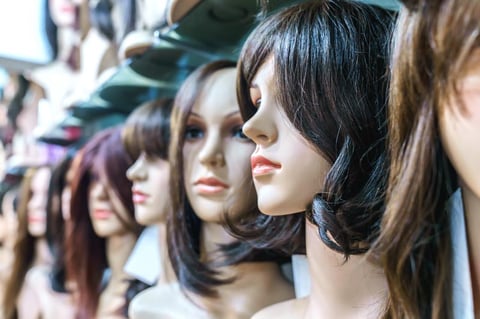Why are Wig Prices Rising? COVID's Impact on the Wig Industry

why are wig prices going up? Hair Shortages & Manufacturing Delays Hit Alternative Hair Industry
Have you noticed your grocery haul is a bit more expensive lately? That filet mignon from your favorite steak house seems a few ounces smaller. Renovating? You've probably noticed contractor costs are higher, and contractors report higher material costs, too. Overall, prices are rising across all industries.
A city of cargo ships sits anchored and stagnant along the coast of Long Beach. Where is the wig you ordered three months ago? Why is the price of hair extensions increasing?
Every industry, market and supply chain is experiencing the effects of inflation. In October 2021, the U.S. inflation rate rose to 6.2%, the highest rate in over 30 years. So much has changed since then, yet the economic landscape is in a state of reversion as all industries — steel, wood, hair, furniture, energy, medical services, e-commerce, food, you name it — take a hit.
This has been an ongoing escalation since the lockdowns of 2020. Now there's a shortage. Customers will have to pay more and be more patient.
Unfortunately, the alternative hair industry is in no position to dodge these industry-wide challenges. The global economic aftershocks from COVID-19 lockdowns are disrupting manufacturing on all fronts. As an alternative hair consumer, you have experienced or will experience the brunt of these effects.
Daniel Alain is a leading authority in the hair industry, and spent decades mastering the art of designing and manufacturing luxury Follea European human hair wigs and toppers. Before launching his own brand and legacy in 2004, owner Daniel Alain Hafid worked alongside his father, a renowned hair stylist and founder of fashionable synthetic wig brand, René of Paris Wigs, for 30 years.
With expertise in both synthetic and human hair wig manufacturing, Daniel learned every facet of wig craftsmanship, and became keenly attuned to women’s desire for beautiful hair. His expertise and passion propelled him into the hair science realm, and into the lab to research and develop innovative breakthroughs and patented, proprietary solutions including INTACT, and the Minoxidil Response Test. At the heart of the company is the unwavering mission to help people suffering from hair loss with proven-effective solutions, emerging research, and transparency about the inner workings of the wig industry. In this article, we'll outline the contributing factors of price increases in the alternative hair industry. We'll also suggest ways to mitigate the costs and make informed purchases.
HOW HAVE SUPPLY CHAIN DISRUPTIONS AFFECTED THE HUMAN HAIR WIG INDUSTRY?

You may have noticed the extreme delays in delivery times for wigs and hairpieces, or that many products are out of stock. Many factors contribute to these disruptions — from price increases for goods and delays in production to abandoned factories following lockdown orders and staff shortages when operations recommenced.
Amazon has made instant gratification accessible for consumers. Same-day delivery? Yes, please. Disruptions to the supply chain have perpetuated the prolonged wait times you’re seeing. Unfortunately, you can't get a high-quality human hair wig through Amazon Prime.
Wig consumers and hair retailers alike are regularly waiting one year or more to get their orders. The question remains: why?
China is the largest exporter of wigs and alternative hair to the U.S., according to data from Statista. In fact, China exported roughly $1.3 billion in wigs and alternative hair to the U.S. in 2018. How does this impact the incomprehensibly long lead (delivery) times for hair to American consumers and retailers? Because China's exports are roadblocked by energy shortages, lockdowns, and staff shortages. For consumers, this means that their order is going to take upwards of a year to ship and that the price tag for the product is going to be higher.
why is the cost of alternative hair increasing?

In the alternative hair industry, shoppers want beautiful hair, whether to conceal balding, hair thinning, or to have greater styling versatility. There are many reasons why people buy alternative hair, from medical to personal style. In this regard, the hair business has proven to be recession-proof. That's good news for the demand but doesn't help with the problem of low supply.
In an industry that functions on the accessibility to supply driven by a $5.57 billion market demand, any upset to the supply method will account for price increases and long wait times. In addition to inflation, what else is driving up the costs and delays in the alternative hair industry?- Increases in material costs
- Hair shortages
- Lace shortage
- Worker shortages
- Energy cuts in China
- Increased demand
- Shipping cost increases and delays
Increase in Material Costs
In the U.S., raw material costs have skyrocketed this year. As of June 2021, compared to a year ago, the cost for cotton increased by 35%, and natural rubber increased by 70%. Costs for all materials are rising, including synthetic and human hair prices, lace for cap construction, and factory equipment.
For example, here at Daniel Alain, we’ve experienced an approximate 40% increase in production costs in 2021. Additionally, the cost increases in transportation and oil have hiked up our delivery and energy costs at our factory in China and our retail showroom in California.
The truth is that no brand in the alternative hair arena is safe from these increases.
Chinese wig producer Zheng Jiangmin cites a 10% increase in raw materials for synthetic wigs. If the synthetic wig market sees cost increases, imagine what's happening to the human hair market where access to high-quality human hair is already limited. InStyle writer Alden Wicker compares the rarity of human, or Remy hair, to an elite Hermes Birkin bag.
Hair Shortage
The U.S. Institute for Manufacturing (ISM) cited a supplier delivery index of 78.8 in May 2021, a four-point jump from April. Anything above 50 indicates slow delivery, and supply isn't only hurting in the U.S. The supply of human hair in Asia is dwindling as wig manufacturers scramble to meet their customers' demands while dealing with delays in their hair materials.
Slow delivery across the hair industry has resulted in hair shortages for many wig manufacturers. Many Asian countries were forced to slow or stop transportation by closing their borders for months at a time due to COVID lockdowns and restrictions.
For example, Thailand, Indonesia, and China had different regulations and lockdowns, making supply chain processes disjointed and inconsistent, causing hair shortages.
Given these shortages, the cost of human hair has increased almost ten times.
Now, the hair supply has diminished for all wig manufacturers. While brands once had direct access to hair from donors, that supply isn't replenishing at its usual rate, resulting in a shortage of human hair wigs.
The common practice for human hair manufacturers is to buy hair from donors at temples in India However, as temples closed down and in some regions were only open once a week, donors were harder to reach, cutting off the largest supply of human hair contributed to the global wig industry.
For manufacturers, this means they have to pay top dollar for quality hair. And that cost gets passed to the consumer, too. Not surprisingly, some brands have chosen to use lower-quality hair to keep costs down. Unfortunately, while the consumer pays the same price for a hairpiece, the quality lowers, resulting in a higher turnover of wigs, and putting the same customers into the waiting pool for a new hairpiece.
Lace Shortage
For the best wigs, human hair isn't the only material. Lace is another essential material of human hair wigs, including ours at Daniel Alain. Our wig caps are made with premium hand-tied Swiss lace. Some of our wigs also have either a small lace front or a temple-to-temple lace front to give you the appearance of a natural hairline with your wig.
So, you’re probably wondering - is there a lace wig shortage?
Unfortunately, yes, and because lace is an essential material for high-quality human hair wigs, the lace shortage is yet another factor contributing to price increases and longer wait times as brands scramble to secure supplies of lace.
Many lace exporters reduced their volumes due to the shortage, contrasting with consumers' increased demand for lace wigs.
Worker Shortages
China is experiencing a labor shortage across all its factories for a few reasons. The COVID-19 pandemic made potential factory workers nervous about leaving their hometowns to pursue work in the big cities. And, the younger generation is more interested in the white-collar field than in the blue-collar factory career.
Moreover, many factories shut down due to lockdowns and economic distress. Even factories with reduced hours can't hold onto full-time workers, as they search for more stable work elsewhere. When these factories reopened, companies struggled to re-engage their workers.
Our Daniel Alain factory in Weihai, China, experienced similar challenges, and we offered our skilled artisans' salary increases to retain their services and loyalty. But many wig factories cannot provide higher salaries amidst the other rising costs, despite the reality that higher wages are needed to attract more workers and retain them.
Without a full staff to populate the production line, manufacturers can't operate at total capacity, meaning it takes them longer to produce every hairpiece, lowering the factory's output and, you guessed it, delivery time.
Electricity Cuts in China
China caps electricity rates to protect the citizens from steep power prices. However, that cap meant China had to create ways to address the sharp increase in coal production and subsequent price increases at the start of 2021. With such little profits for coal companies, entire coal power plants shut down.
China's solution has been rationing electricity. Consumers in Southern China are allowed 3-7 days of weekly power. For sectors that use a lot of energy, like wig factories, the rations are greater. China is trying to prevent nationwide power outages and lower energy intensity by 13.5% and carbon emissions by 18%, as outlined in its 5-year economic plan.
In October 2021, Daniel Alain's factory in China was only allowed to operate a few days out of the week, delaying our supply and making it more difficult to retain workers.
You might have noticed a few wigs out of stock or taking longer to deliver. Why are wigs sold out? We experienced a high volume of back orders with these reduced hours since our factory wasn't running at full efficiency, affecting production and delivery times.
Daniel Alain owns every step in the production line for our wigs and hair toppers, but this control over production is not common. Most brands outsource tasks in the production line. This adds another layer to the delay, as the brand now has to wait on the supplier of a specific service while that supplier is also experiencing delays.
The lead time for a wig or hairpiece from an alternative hair brand is four weeks to 1.5 years. All of the factors discussed here dictate the lead time, and each manufacturer is affected uniquely. The common thread, however, is that every brand in the wig industry is taking a hit.
Rising Demand
The design of a thriving economy relies on supply and demand. However, when there isn't an equilibrium between the two, the economy falters. When supply shortens, prices increase.
A decrease in supply hurts wig manufacturers even if demand stays the same. With low inventory, companies can't keep up with their orders. Now imagine if the demand increases when the supply is down, as it continues to do in the alternative hair industry? After all, the wig market is projected to grow by 13% from 2021 to 2026.
To meet the demand, alternative hair manufacturers really only have two options:
- Raise prices on existing supply to cover increased manufacturing costs
- Use lower quality hair which is more readily available
Shipping Delays and Cost Increases
Not only have production delays lengthened the time it takes for wigs to make it to customers, but FedEx is also causing delays for Daniel Alain and thousands of other companies due to its worker shortages. Additionally, its increased prices are resulting in more costs for all wig manufacturers.
Some may choose to have their hair freight delivered, but this is yet another exorbitant cost. To shorten lead times, it may be a bandaid, but at what cost? Furthermore, who is expected to pay for the cost? The brand or the consumer? Therein lies the problem. Either way, it's not a sustainable delivery strategy because it's simply too expensive. Thus, customers have to get comfortable with expecting prolonged delays.
If a brand can promise a quick lead time, the consumer may want to do a little digging into why that is. For Daniel Alain, our private stock of genuine European hair was acquired from decades of collection, but it isn't infinite. However, Daniel Alain is the only company with access to this stock. So, if a company alleges that it isn't experiencing a shortage, you have to wonder what kind of hair they're using.
HOW WE SOURCE HAIR FOR DANIEL ALAIN FOLLEA WIGS & TOPPERS?

Amidst all of these factors affecting the alternative hair industry, Daniel Alain owns the whole production line of manufacturing our wigs and toppers. We have a great workforce that remains loyal to us. This loyalty results from positive, healthy working conditions, good pay, and opportunities for ongoing training, education, and lifestyle support via transportation, access to healthy meals, and prioritized initiatives to support staff well-being.
We're also unique in having our reserve of European hair that no one else has, ensuring that we at least have the 100% premium human hair that our clients love and cherish.
But we are not unchallenged by the current economic state. Our challenges lie in the unprecedented cost increases we've experienced in transportation, labor, and shipping, as well as our delays in production, which come with their own costs. These are the primary reasons behind our price increase. However, our biggest challenge is sourcing the World Select Hair used for our René wig collection.
Our World Select Hair comes from a blend of high-quality Asian ponytails across the region - never floor hair. However, with COVID-19 border closures, collection methods for highly sought-after ponytail hair have been strained.
how you should plan for price increases for wigs & hairpieces?
We've covered all of the reasons why you're seeing price increases for wigs and hairpieces. Below are our suggestions for how you can better prepare for the price increases and make the most out of your purchase.
Invest in Quality Hair
As you shop for wigs and hairpieces, focus on buying high-quality hair. It may sound counter-intuitive, but investing in a higher-quality hairpiece will save you more money in the long run, especially when considering human hair vs. synthetic wigs. Human hair wigs tend to last longer than synthetic wigs, and they also blend more naturally with your natural hair. If you need more guidance on choosing a wig, you'll find all the crucial factors you need to consider in this wig buying guide.
Good quality hair costs more, and the price increases might urge you to look at more affordable wig options. Your purchase is an investment into your confidence and appearance. It’s going to shape the way you feel and present yourself to the world.
If you invest in a low-quality wig, you might anticipate short-term savings; however, the purchase will cost you more money when you need to replace it, time to find an alternative (4 weeks to 1.5 years), and frustration if the wig doesn't last.
Daniel Alain Follea wigs and toppers are of the highest quality, made with 100% European human hair. Our wigs are hand-tied and built to last longer than the majority of other wigs on the market.
But even still, you'll need to learn how to take good care of the hair to increase its longevity.
Take Great Care of Your Wig or Topper
100% human hair wigs from brands with a reputation for high quality and customer satisfaction will last longer than cheaper hairpieces. But just like any investment, you should take extra care to maintain your wig or topper to preserve its quality and prolong its lifespan.
For example, we recommend securing your wig to a head mannequin before washing it. This ensures that you don't invert any of the hairs through the cap. Avoid sleeping and swimming in your wig, and minimize your application of hairspray.
Check out our wig care and maintenance guide for tips and best practices in caring for your human hair wig.
Shop from Brands Offering Payment Plans and Buyer Incentives
Many companies have payment plans, referral programs, special discounts, and promotions for their customers. For example, Daniel Alain has financing options in place to offset the price of our products. Space out your payments with either an Affirm or Paypal payment plan for greater flexibility.
We offer a 10% military discount to active, national guard, reservist, veteran, and retired U.S. military personnel and their spouses and dependents.
You can also earn credits of $200+ for Daniel Alain products when you join our referral program.
We aren't the only brands that consider our customers' financial needs. Whichever brand you shop from, check their website or reach out to a customer representative to inquire about your options. Good brands make an effort to learn how to help their customers and offer ways to accommodate their financial needs.
Check with Your Insurance Provider for Coverage
Hair loss is a medical condition for many, and some insurance policies offer coverage. Check with your insurance provider to see if your current policy provides financial support for your wig purchase.
Alopecia is a medical issue, and the term for a wig is "cranial prosthesis." Insurance provider Blue Shield offers some coverage for people with alopecia. Submit a claim with the guidance of an insurance representative and doctor, and if it's denied, always appeal! It's worth your effort, as some patients have had insurance providers pay for a year's worth of their wig use.
SHOULD YOU WAIT FOR WIG PRICES TO COME DOWN?
Some experts assert that inflation will settle down, though even experts can't predict when or by how much. Others agree that inflation has lasted longer than the experts predicted it would. The point is: it's not clear how or when prices and delays will change. We don't have a crystal ball — we can only work with the information we have now.
Typically, when brands have to raise their prices, it's not common to lower them, considering all of the other rising costs contributing to the price increase.
We know at Daniel Alain that our material costs are rising, and the increases are significant enough to necessitate a price increase on our product line. We aren't shying away from disclosing the reasoning behind our price increase. We believe that equipping you with transparent knowledge about the basis for these increases will give you a better understanding of the state of the industry, which can help you feel more confident about your purchase.
Ultimately, but we don’t anticipate prices will come down. Some consumers may not have the financial means to afford these increases. However, we offer payment plans to help make the price increases more manageable.
Whatever decision you come to, your motivation for beautiful hair should guide you. And in your quest, learning about the factors shaping the current state of the industry will help you make an informed purchase.


